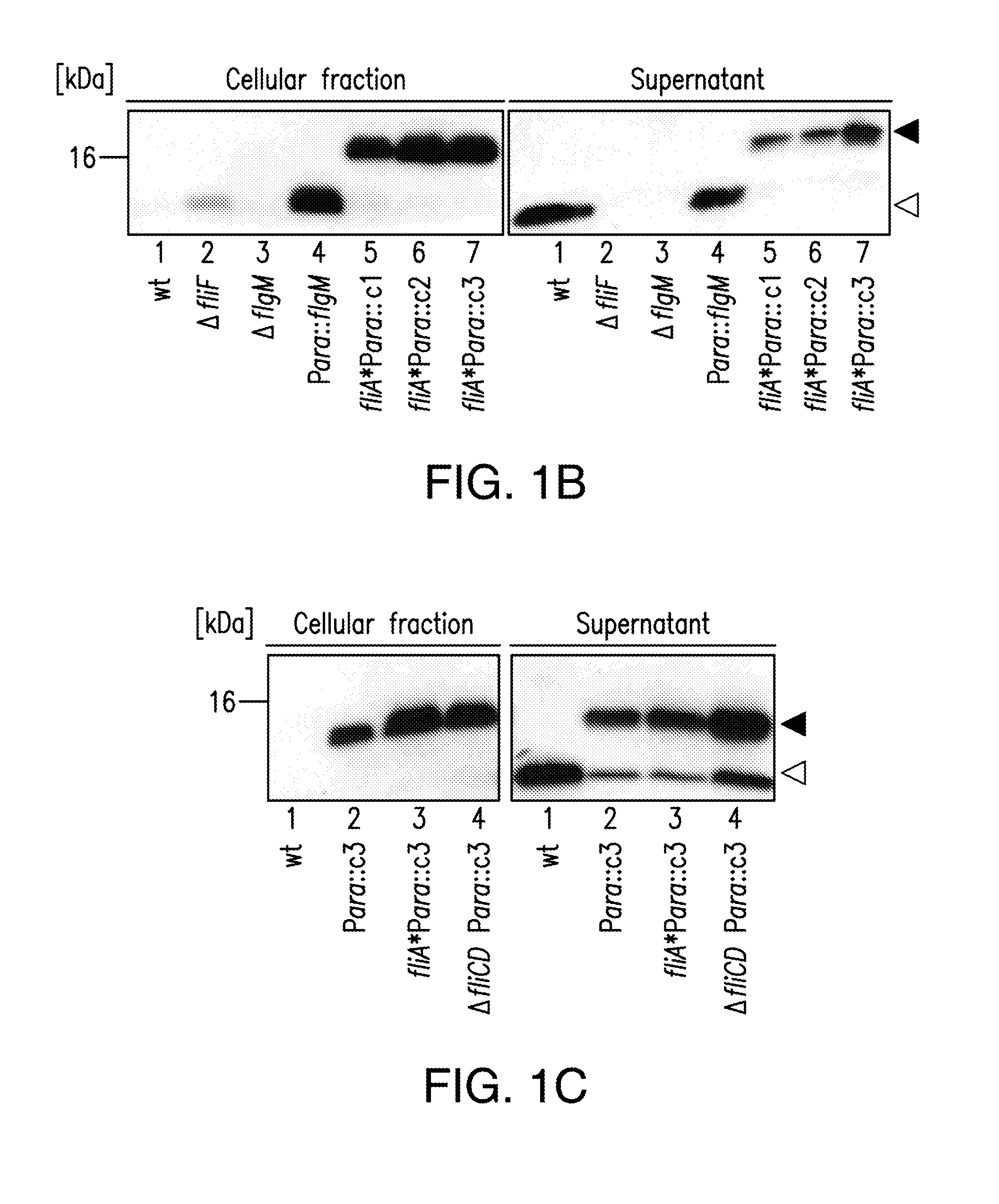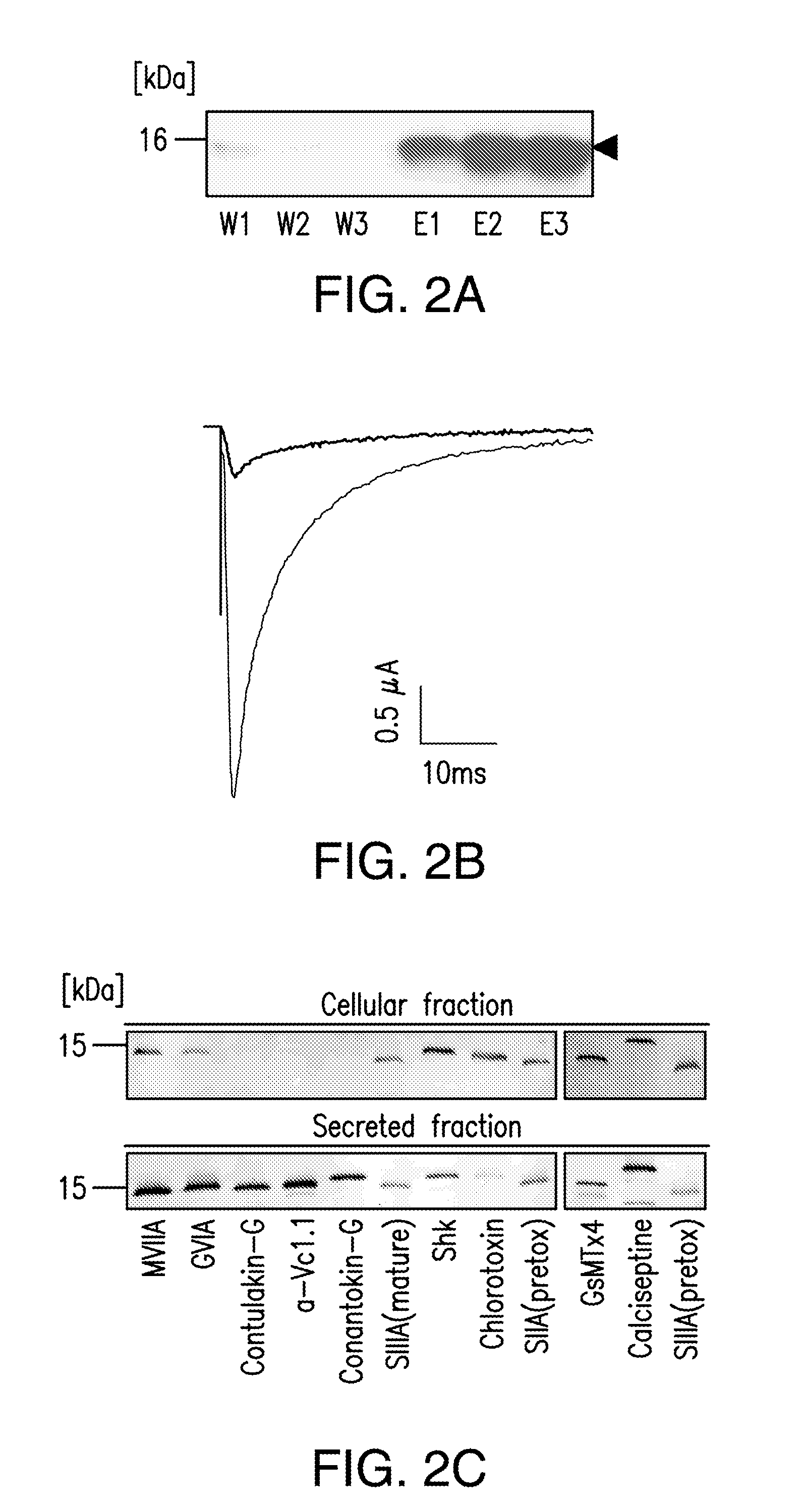Compositions and methods for peptide expression and purification using a type iii secretion system
a secretion system and peptide technology, applied in the field of compositions and methods for peptide expression and purification using a type iii secretion system, can solve the problems of low yield, difficult to efficiently express certain classes of proteins, and formation of intermolecular aggregates, and achieve the effect of improving the yield of secreted proteins
- Summary
- Abstract
- Description
- Claims
- Application Information
AI Technical Summary
Benefits of technology
Problems solved by technology
Method used
Image
Examples
example 1
A. Example 1
Selective Purification of Recombinant Neuroactive Peptides Using the Flagellar Type III Secretion System
[0118]In this work the flagellar FlgM protein was utilized as a vector for the secretion of the small, highly stable pharmacologically-active polypeptides that contain a high density of cysteine residues, which form disulfide crosslinks in the mature product. As a proof-of-principle, a bacterial secretion system was engineered for the recombinant expression of μ-conotoxin SIIIA in Salmonella typhimurium. Using the flagellar type III secretion (T3S) apparatus, the recombinant conotoxin was selectively secreted into the culture medium, as shown in FIG. 1.
[0119]1. Materials and Methods
[0120]i. Bacterial Strains, Plasmids and Media.
[0121]Exemplary bacterial strains that can be used are listed in Table 1. Cells were cultured in Luria-Bertani (LB) media and, when necessary, supplemented with ampicillin (100 μg / ml) or tetracycline (15 μg / ml). The generalized transducing phage...
example 2
B. Example 2
Analysis of Factors that Affect Salmonella FlgM Protein Secretion
[0159]In this work, a new approach was initiated that uses an expression system that bypasses the inclusion body problem of recombinant small peptide expression. It exploits the flagellar secretion system of Salmonella enterica serovar Typhimurium (Salmonella typhimurium) that has been shown to export non-flagellar proteins if fused to flagellar secretion signals, e.g. hook protein FlgE or flagellin FliC. The flagellar secretion system is a member of a family of bacterial type III secretion systems that selectively secrete proteins from the cytoplasm to the external medium. Almost all type III secretion systems characterized thus far are either required for the secretion of virulence determinants for a number of plant and animal pathogens or for the secretion of proteins required for the structure and function of the bacterial flagellum. The bacterial flagellum is composed of an external helical filament, e...
example 3
C. Example 3
Large-Scale, Type III-Dependent Protein Production Via Direct Secretion into the Growth Medium
[0211]The use of FlgM as a secretion signal to facilitate secretion of previously difficult to produce proteins, such as conopeptides with numerous disulfide bonds and the A subunit of diphtheria toxin, which is not detectable in the cytoplasm due to its instability, demonstrates the utility of this system for protein production and purification of proteins that otherwise are not produced.
[0212]Using lambda RED technology for chromosomal targeting, this system can revolutionize bacterial genetic strain construction. In the desired genetic background the araBAD operon can be replaced by a tetRA element. The tetRA element can be the tetR and tetA genes from transposon Tn10 that code for a tetracycline efflux pump (TetA), which confers resistance to tetracycline, and the TetR repressor. This can be accomplished by PCR-amplification of the tetRA element using 48-mer oligonucleotides...
PUM
| Property | Measurement | Unit |
|---|---|---|
| pH | aaaaa | aaaaa |
| pore size | aaaaa | aaaaa |
| pH | aaaaa | aaaaa |
Abstract
Description
Claims
Application Information
 Login to View More
Login to View More - R&D
- Intellectual Property
- Life Sciences
- Materials
- Tech Scout
- Unparalleled Data Quality
- Higher Quality Content
- 60% Fewer Hallucinations
Browse by: Latest US Patents, China's latest patents, Technical Efficacy Thesaurus, Application Domain, Technology Topic, Popular Technical Reports.
© 2025 PatSnap. All rights reserved.Legal|Privacy policy|Modern Slavery Act Transparency Statement|Sitemap|About US| Contact US: help@patsnap.com



